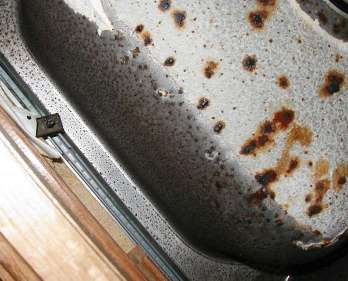
 |
On Thursday, November 15th 2001, I met with Kerri to discuss her stainless steel sink corrosion problem. She and her husband have a three year old boy and 14 month old girl. They have been in this house for about 18 months. She said that about three months ago she noticed that the can of Comet cleaner that was stored under the island sink counter arrangement in her kitchen had considerable corrosion on the metal top. When she looked in the cabinet under the sink she noticed that the bottom of the sink and the copper tubing and fittings were all corroded. She got on the internet looking for corrosion information and ended up having their problem aired on the NACE Corrosion Network through the Corrosion Doctors Webmaster.
The double basin sink flange was very slightly magnetic but the knuckle and the basins were increasingly magnetic, with the bottom of the basins very strongly magnetic. I'm certainly not an expert on kitchen sinks but would suspect that this is consistent with cold formed type 302 stainless which I seem to remember is used for kitchen applications.
| There were some scattered rusted pitted areas on the top side of the sink with extensive rusting on the bottom side. Part of the underside of the basins was coated with a white pipe dope type material that appeared to be similar to that used on the plastic piping in the cabinet. The bottom of the basin, the sides and the bottom of the flange were rusted. Close examination on the top side revealed several cracks running from the flange over the knuckle down the side of the basin. At least one crack on the left basin was through wall. |
 |
All of the metal parts in the cabinet under the sink were corroded. All of the brass/copper fittings and tubing had a heavy green corrosion product on them. All the metal parts that I assume were chrome plated were severely rusted, as were all the cabinet door hinges and screws, as well as the hose clamps. I checked all the other cabinets and lines that were accessible in the bathrooms.
 |
Only one other fitting had a trace of green corrosion product on it. It was in a cabinet in a downstairs bathroom. Kerri mentioned that although she had removed all the cleaning products from under the kitchen sink about three weeks before, she kept foil and saran wrap type products under the sink. The cutting edge of both the foil and saran wrap boxes were only about three weeks old and were starting to corrode. |
About three weeks ago she had boxed all the materials that had been stored under the sink and stored them in the garage. I went through all of them. There was a toilet bowl cleaner that had HCl in it, soft scrub with bleach, and two shower scrub products, one had a chelating agent and the other an organic oxidate scavenger.
No other products looked suspicious. Kerri said that she had never used the toilet bowl cleaner on the sink. There was no evidence that the bottle was leaking or had leaked. She advised that the only cleaners she had used on the sink were Comet and the soft scrub product. She also advised that a roll of aluminum foil that had been in the cabinet had extensive white corrosion product on it but had been thrown away. There was a double plug electrical receptacle at the back of the cabinet. I took the cover off it to check and see if the copper wire was corroded like the rest of the brass/copper in the cabinet. It looked pristine. Kerri said that the builder had a plumber look at the situation and had then volunteered to replace all the corroded metal parts under the sink including the sink.
I certainly won't claim to be a household corrosion expert but it sure looks like a chloride problem. We don't have a good time frame on the problem other than the evidence that there is still some corrosion going on. Possible sources of the corrosion seem to be the cleaning products or an outside chance of some kind of problem coming from underneath the slab up into the island cabinet. The subdivision backs up on a lake which was formed, I suspect, from an old gravel pit. It is certainly possible that it was a dump site for who knows what. However, after we had an initial conversation, Kerri did check with several neighbors and no one has a similar problem.
I suggested to Kerri that she use some SOS pads with the soap washed out as corrosion coupons to check on the current corrosion situation on top and under the sink. As a fix for the current problem, I suggested that Kerri take up the builders' offer to replace the corroded metal parts. I did suggest that she keep all of the old parts for future reference. However, I suggested to Kerri that she not sign off on anything from the builder that would imply that all the house's problems were solved. I have several pictures of the corrosion problem that I would be glad to send directly since I would assume there may be firewall problems in some organizations.